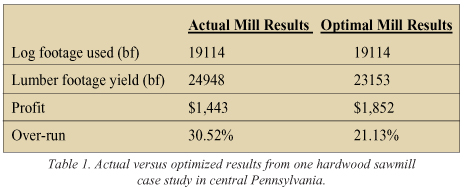The sawmill industry today faces many challenges: the amorphous nature of global competition, the housing boom and bust, environmental concerns, etc. But the inherent qualities of wood make it an important material; there seemingly will always be demand for softwood and hardwood lumber. As sawmills compete for raw material and markets, only those that evolve and improve management techniques will survive. There are various factors which contribute to the profitability of the typical sawmilling operation, such as log prices, log allocation, sawmill utilization, labor cost, logistics, etc. However, one ubiquitous management metric is usually found to be common to modern sawmill operations: the metric Over-Run.
In sawmill operation, there is always some disparity between log scale and lumber yield, which is known as either over-run or under-run. If the lumber output is greater than that predicted by the log scale, then the excess difference is called the over-run. Over-run is usually measured as the difference between the scale of a log and the board foot measure in that scale of the lumber obtained from the log expressed as a percentage of log input. It is typically calculated by the following formula:
Percent of overrun =
((Lumber output – log scale)/log scale)
× 100
There are different log scales by which over-run is measured. The Scribner Log Rule is a common method of predicting lumber volume from specific logs, and is used frequently in the Northeastern United States hardwood lumber industry to establish the market value of logs. The Scribner scale was developed in 1846 based on a series of sawing diagrams of 1-inch lumber in various log length and diameter classes, allowing for a ¼” saw kerf (sawdust lost from lumber volume due to the sawing process) between each board. However, the Scribner scale, like all other log scales, was developed to estimate the lumber footage potential of a log, not the lumber value potential.
The Scribner, like many other log scales, tends to be conservative and underestimate the lumber potential of certain log categories. Since over-run measures, in effect, the error of the log scale used, sawmill managers have considered the metric to be an accounting of the amount of “free wood” produced from their mill, because the log was purchased based on this conservative log-scale estimate of lumber potential. From that line of thought evolved the common belief that higher over-run, since it indicates more “free wood” produced by the mill, necessarily indicates higher profitability. Therefore, most sawmill managers believe that over-run is an excellent indirect indicator of operational profitability.
However, little or no formal work had been published to support this common belief; that is, until a Penn State research team published a paper in the academic journal Wood and Fiber Science entitled “Impact of overrun on optimal performance of hardwood sawmills.”
The study showed that no reliable relationship exists between mill over-run and mill profitability, either actual or optimal. By optimizing the log mix into the sawmill, it was proved that higher profitability can be achieved with lower over-run. Table 1 on page 28 provides one set of results obtained through actual sawing to “maximum over-run” management criteria versus a more profitable scenario where log mix into the mill was optimized relative to log and lumber market conditions, without consideration of potential over-run.
While the results from this one case study do not necessarily represent all sawmill operations, nor disclude certain situations where maximum over-run might result in the best profit scenario for any certain set of market conditions, they do lend support to the hunch that many mill managers have had over the years: that by purchasing small or lower-grade logs in order to maximize over-run and minimize raw material cost, they are realizing lower than optimal profitability from their mill operation. Our findings suggest strongly that over-run should not be used as a measure of mill efficiency, or allowed to influence log purchasing strategy, because of the possible negative profit impact the resulting decisions could have.
A better alternative for measuring mill efficiency is to measure actual yield of the processed logs against an established mill standard yield by log and lumber grade. The best solution, in terms of capturing potential mill performance, is to optimize the log mix for any particular sawmill through an appropriate log mix linear programming optimization model, similar to the one stated
in the paper referenced earlier, and
reconciling actual mill performance against the theoretical optimum at regular intervals.
If your company does not have the software tools to perform this mill optimization analysis, there are consultants and software available for your use. Some of those you may consider are: Halco Software Systems, The Beck Group, and BestPossible Soltions, Inc.
Another option to consider, if you’re really serious about making the most you can out of your sawmill operation, is to hire an industrial engineer to perform the necessary mill studies and develop the computer models necessary to continually make the optimal management decisions for your mill. Any good engineering program produces a number of qualified industrial engineers every year; the Harold and Inge Marcus Department of Industrial and Manufacturing Engineering at Penn State is one of the very best in the country.
The advantage of having your own industrial engineer on staff is that mill optimization is an ongoing and dynamic process, and short-term gains can be quickly lost with market moves and mill upgrades. A good industrial engineer is worth his or her weight in gold to any competitive sawmill or plywood operation.
Dr. Chuck Ray is a wood products operations specialist at Penn State University. He can be reached by email at cdr14@psu.edu.




